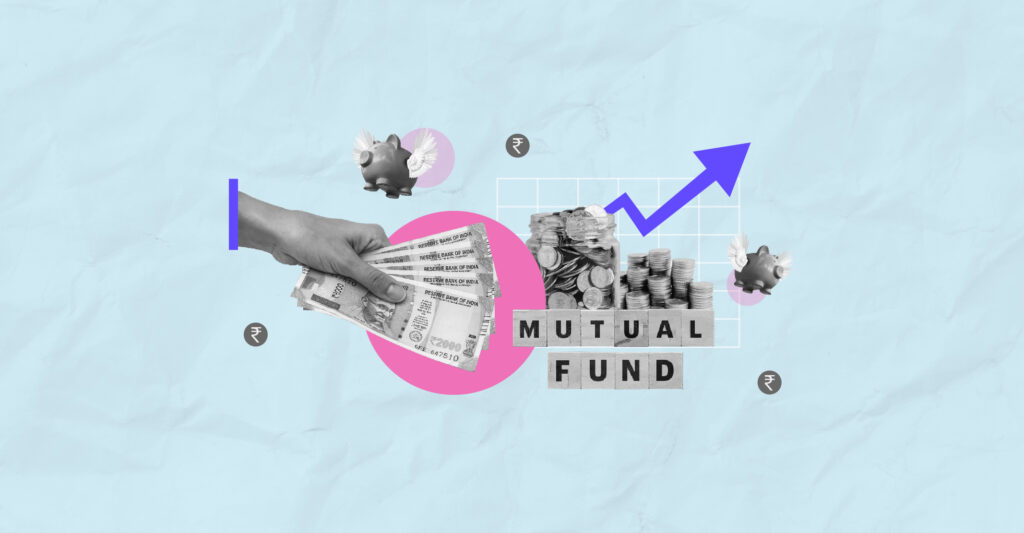Last Updated on Jul 30, 2024 by Anjali Chourasiya
Wealth creation involves investing in long-term instruments. As an investor, you wish to invest in instruments that are profitable for you. For this purpose, a high-return mutual fund can be a good choice. They are equity funds, carrying high risk and delivering high returns. Explore them and list the top high-return mutual funds based on their 3-year CAGR by reading on!
Table of Contents
Top 10 High Return Mutual Funds in India for Long-Term in 2024
| Fund Name | AUM (Rs. in cr.) | CAGR 3Y (%) | Expense Ratio (%) | SIP Investment |
| Nippon India Large Cap Fund | 24,378.39 | 27.89 | 0.72 | Allowed |
| HDFC Top 100 Fund | 32,355.19 | 23.62 | 1.05 | Allowed |
| ICICI Pru Bluechip Fund | 51,554.28 | 23.60 | 0.83 | Allowed |
| JM Large Cap Fund | 99.50 | 22.89 | 0.92 | Allowed |
| Invesco India Largecap Fund | 983.38 | 22.17 | 0.76 | Allowed |
| Baroda BNP Paribas Large Cap Fund | 1,863.39 | 21.96 | 0.90 | Allowed |
| Edelweiss Large Cap Fund | 770.84 | 21.08 | 0.75 | Allowed |
| Tata Large Cap Fund | 2,019.22 | 20.31 | 1.14 | Allowed |
| ITI Large Cap Fund | 250.49 | 20.22 | 0.47 | Allowed |
| Bandhan Large Cap Fund | 1,380.13 | 20.10 | 0.90 | Allowed |
Note: The list of top 10 high-return large-cap high CAGR mutual funds is curated using Tickertape Mutual Fund Screener on the date 30th April 2024 by using the following parameters –
- Category: Equity > Large cap fund
- Plan: Growth
- 3-yr CAGR: Sorted from highest to lowest
🚀 Pro Tip: You can use Tickertape’s Stock Screener to research and evaluate stocks with over 200+ filters and parameters.
Confused about which mutual funds to pick? Consider exploring smallcases:
smallcases are modern investment products that help investors build low-cost, long-term & diversified portfolios with ease. A smallcase is a basket or portfolio of stocks/ETFs representing an idea – an objective, theme, or strategy. They are created and managed by SEBI-registered experts.
Some of the popular smallcases amongst new investors are as follows:
Note: These smallcases are mentioned only for educational purposes and are not meant to be recommendatory. Investors must conduct their own research and consult a financial expert before making any investment decisions.
Disclosures for the aforementioned smallcases.
Overview of the Top 10 High Return Mutual Funds (Large-Cap)
Nippon India Large Cap Fund
Nippon India Mutual Fund is a prominent mutual fund company in India. It has swiftly risen as one of the fastest-growing AMCs since its June 30, 1995 registration. It was originally known as Reliance Capital Mutual Fund and rebranded itself in 2004. The fund has generated better returns than other funds in its category. Furthermore, it has also been able to get a better price return than FDs. Its lower expense ratio also indicates that the fund is suitable for potentially better returns in the long term.
HDFC Top 100 Fund
The HDFC Top 100 Fund is a large-cap mutual fund scheme by HDFC Mutual Fund. It has been operational since its launch on 4th September 1996. The fund has delivered 15.06% average annual returns since its inception. The fund has demonstrated the ability to deliver consistent returns, and this ability has also been higher than other funds in its category, making it one of the top funds in its category. The high-risk, high-return mutual fund has also generated better returns than FDs.
ICICI Pru Bluechip Fund
ICICI Prudential Bluechip Fund is a large-cap mutual fund by ICICI Prudential Mutual Fund. It has been operational since its launch on 23rd May 2008. Over the past year, it has yielded returns of 40.95%, with an average annual return of 16.63% since its inception. Compared to its peers, this scheme demonstrates a superior ability to deliver consistent returns and above-average loss control during market downturns. It also has a lower expense ratio than its peers, making it a suitable investment for generating long-term returns.
JM Large Cap Fund
JM Financial Mutual Fund offers the JM Large Cap Fund, which is a large-cap mutual fund scheme that has been operational from 15th September 1994. Over the last year, the fund has yielded returns of 47%. Since its inception, it has maintained an average annual return of 14.37%. The scheme’s performance aligns with industry standards, demonstrating its capability to deliver consistent returns. Moreover, it exhibits a high proficiency in minimising losses during market downturns. Furthermore, the fund’s returns have also been better in comparison to FDs. It’s lower expense ratio also makes it ideal for long-term investments.
Invesco India Largecap Fund
Invesco India Largecap Fund is a large-cap mutual fund by Invesco Mutual Fund. It has been operational from 24th July 2006. Over the past year, it yielded returns of 41.64%, with an average annual return of 16.23% since inception. This fund’s consistent return performance aligns with its peers in the category. Its ability to mitigate losses during market downturns is moderate. The fund has been able to generate better price return than FDs. It also has a lower expense ratio, making it potentially ideal for generating higher returns in the long-term.
Baroda BNP Paribas Large Cap Fund
Baroda BNP Paribas Large Cap Fund is a part of the Baroda BNP Paribas Mutual Fund. It has been active from 24th September 2004. Over the past year, it has reflected returns of 40.82%, with an average annual return of 16.74% since its inception. This fund’s consistent return delivery aligns with its peers in the category, demonstrating the above-average ability to mitigate losses during market downturns. Furthermore, it has a lower expense ratio of 0.90%, making it ideal for generating potentially higher returns in the long term.
Edelweiss Large Cap Fund
Edelweiss Mutual Fund offers the Edelweiss Large Cap Fund is a large-cap mutual fund scheme. It was launched on 20th May 2008 and has been active since. Over the past year, it has yielded returns of 35.42%. Since its inception, it has provided an average annual return of 15.83%. This fund demonstrates consistent performance compared to others in its category and exhibits the above-average ability to mitigate losses during market downturns. The fund has been able to generate better price return than FDs. Furthermore, its lower expense ratio makes it an ideal fund for generating potentially higher returns in the long-term.
Tata Large Cap Fund
Tata Large Cap Fund is a mutual fund from Tata Mutual Fund. It was introduced on 7th May 1998 and has been active ever since.. Over the past year, it has yielded returns of 35.19%. Since its inception, it has maintained an average annual return of 14.74%. This performance aligns with comparable funds in its category. However, its capability to mitigate losses during market downturns is moderate. Notwithstanding, it has also demonstrated better price return than FDs. Furthermore, its lower expense ratio implies the potential ability to generate better returns over long-term.
ITI Large Cap Fund
ITI Large Cap Fund was launched on April 12, 2020. It has a track record of 3 years and 4 months. Over the past year, it yielded returns of 42.68%. Since its inception, it has maintained an average annual return of 19.76%. This fund consistently returns, aligning with its peers in the category. Moreover, it exhibits above-average ability to mitigate losses during market downturns. It has a low expense ratio of 0.47%, lower than its peers in this category, making it an ideal fund for generating potentially higher returns over the long term.
Bandhan Large Cap Fund
Bandhan Mutual Fund offers the Bandhan Large Cap Fund. It is a large-cap mutual fund scheme. Over the past year, the fund has shown returns of 37.38%, with an average annual return of 14.05% since its inception. The scheme’s performance aligns well with its category peers in delivering consistent returns. However, its ability to mitigate losses during market downturns is moderate.It has a lower expense ratio and, like its peers, also has the potential to generate better returns over the long-term.
Top 10 High Return Mutual Funds in India (Mid-Cap) in 2024
| Fund Name | AUM (Rs. in cr.) | CAGR 3Y (%) | Expense Ratio (%) | SIP Investment |
| Motilal Oswal Midcap Fund | 8,986.69 | 39.49 | 0.61 | Allowed |
| Quant Mid Cap Fund | 5,873.25 | 38.84 | 0.71 | Allowed |
| Mahindra Manulife Mid Cap Fund | 2,201.78 | 31.87 | 0.48 | Allowed |
| Nippon India Growth Fund | 24,480.78 | 31.72 | 0.81 | Allowed |
| HDFC Mid-Cap Opportunities Fund | 60,417.99 | 31.21 | 0.75 | Allowed |
| Edelweiss Mid Cap Fund | 5,066.57 | 29.23 | 0.43 | Allowed |
| Invesco India Midcap Fund | 4,280.22 | 27.78 | 0.61 | Allowed |
| Sundaram Mid Cap Fund | 10,269.46 | 27.56 | 0.87 | Allowed |
| ICICI Pru Midcap Fund | 5,517.29 | 27.48 | 0.96 | Allowed |
| ITI Mid Cap Fund | 716.25 | 27.27 | 0.43 | Allowed |
Note: The list of top 10 high-return mid-cap mutual funds is curated using Tickertape Mutual Fund Screener on the date 30th April 2024 by using the following parameters –
- Category: Equity > Mid cap fund
- Plan: Growth
- 3-yr CAGR: Sorted from highest to lowest
Top 10 High-Return Small-Cap Mutual Funds in 2024
| Fund Name | AUM (Rs. in cr.) | CAGR 3Y (%) | Expense Ratio (%) | SIP Investment |
| Quant Small Cap Fund | 17,193.09 | 42.13 | 0.70 | Allowed |
| Nippon India Small Cap Fund | 46,044.13 | 37.61 | 0.79 | Allowed |
| HSBC Small Cap Fund | 13,746.58 | 35.56 | 0.70 | Allowed |
| Franklin India Smaller Cos Fund | 11,822.68 | 35.31 | 0.92 | Allowed |
| Tata Small Cap Fund | 6,289.22 | 35.00 | 0.29 | Allowed |
| HDFC Small Cap Fund | 28,598.92 | 34.17 | 0.58 | Allowed |
| Bandhan Small Cap Fund | 4,384.90 | 33.85 | 0.43 | Allowed |
| Invesco India Smallcap Fund | 3,669.91 | 33.24 | 0.46 | Allowed |
| Canara Rob Small Cap Fund | 9,594.98 | 32.91 | 0.51 | Allowed |
| Edelweiss Small Cap Fund | 3,147.36 | 32.41 | 0.41 | Allowed |
Note: This Tickertape mutual fund list of top 10 high-return small-cap mutual funds is curated using Tickertape Mutual Fund Screener on the date 30th April 2024 by using the following parameters –
- Category: Equity > Small cap fund
- Plan: Growth
- 3-yr CAGR: Sorted from highest to lowest
What are High-Return Mutual Funds?
High-return mutual funds carry high risks. They typically invest in equity which is known for its specific risk-reward dynamic. These mutual funds with highest CAGR can typically provide you with high returns. However, their risk-to-return ratio is also significantly higher. That said, while you may make profits, you may just as quickly lose your investment amount.
These funds are volatile and unpredictable. High return mutual funds 2024 are suitable for investors with an aggressive risk appetite.
Features of High-Return Mutual Funds
- Various types: There are ten sub-categories of equity mutual funds as classified by the Securities Exchange Board of India (SEBI). It includes large, mid, and small-cap funds, ELSS funds, focused funds, dividend-yielding funds, thematic and sector funds, etc. Hence, there is a wide variety for you to choose from.
- Risk-reward ratio: The phrase ‘higher the risk, higher the reward’ was perhaps coined for high-return mutual funds. Its risk-to-return ratio is proportional.
- Asset allocation: Equity funds allocate 65% to 80% of assets in equities. Therefore, they are known as ‘high-risk funds’. In a bullish trend, this high asset allocation can be proved to be incredibly profitable while the chances of losses increases in the bearish market.
- Tax benefits: High-return mutual funds can give you tax benefits. For instance, with ELSS funds, there is an option to claim deductions of up to Rs. 1,50,000 under Section 80C. However, you have to pay short-term and long-term capital gains on your returns.
- Investment modes: You can invest in high-return mutual funds in two ways: Systematic Investment Plan (SIP) and lumpsum. The minimum SIP investment goes as low as Rs. 150.
Taxation on Equity Mutual Funds as per the 2024 Budget
Understanding the latest tax regulations on equity mutual funds is essential for making informed investment decisions. The Union Budget 2024 has introduced significant changes to the taxation of equity mutual funds, simplifying the tax structure while altering rates and benefits. Here is a detailed breakdown of the new tax rules:
Short-Term Capital Gains (STCG)
If you hold equity mutual funds for less than a year, the gains from these investments are classified as short-term capital gains. According to the new budget, these gains are now taxed at a rate of 20%, which has been increased from the previous rate of 15%.
Long-Term Capital Gains (LTCG)
For equity mutual funds held for more than a year, the gains are considered long-term capital gains. The key points to note under the new budget are:
- Tax-Free Limit: Gains up to Rs. 1.25 lakh in a financial year remain tax-free. This limit has been increased from the previous threshold of Rs. 1 lakh.
- Tax Rate: Any gains above Rs. 1.25 lakh are taxed at a flat rate of 12.5%. It was previously taxed at 10%.
- Indexation: It’s important to note that the benefit of indexation, which previously allowed investors to adjust the purchase price of their assets for inflation, has been removed for all asset classes, including equity mutual funds.
Indexation is a method used to adjust the purchase price of an asset (like property or gold) for inflation over the years. This adjusted price is then used to calculate capital gains. Previously, long-term capital gains from selling property, gold, or other unlisted assets were taxed at 20%, but you could use indexation to reduce your taxable profit. The new rule simplifies the tax structure by setting a flat 12.5% tax rate for all long-term capital gains. However, it removes the indexation benefit.
Factors to Consider Before Investing in High Return Mutual Funds
- Investment objective: Before diving into any mutual fund, assess if its objectives align with your financial goals. Are you saving for retirement, a child’s education, or building an emergency fund? The fund’s strategy should match your timeline and risk tolerance.
- Risk tolerance: High return often comes with high risk. Evaluate your risk appetite. Can you tolerate the volatility that comes with the potential for higher returns, or would a safer investment make you sleep better at night? It is crucial to decide this before your step into any investment.
- Performance history: While past performance isn’t a guarantee of future results, it can provide insights into how the fund has managed under various market conditions. Look for consistent performance over a longer period, rather than short-term gains.
- Expense ratio and fees: High fees can eat into your returns. Understand the fund’s expense ratio and any additional fees associated with buying, holding, or selling the fund. Lower costs mean more of your money stays invested.
- Fund manager’s expertise and track record: The fund manager’s decisions play a crucial role in the fund’s performance. Research their experience, investment philosophy, and performance history with other funds.
- Asset allocation and diversification: Investigate the fund’s holdings to ensure it’s well-diversified across sectors, geographies, and asset classes. Diversification can help mitigate risk.
- Market conditions: Economic and market conditions can impact fund performance. Consider the current market cycle and how it aligns with the fund’s investment strategy and your own investment objectives.
Risks Associated with High Return Mutual Funds
- Market Risk: The value of investments can go down as well as up due to market fluctuations. High return funds often invest in volatile segments, exposing you to greater market risk.
- Credit Risk: This applies to debt mutual funds. If the issuer of the bond fails to pay interest or repay the principal, it can lead to losses for the fund.
- Interest Rate Risk: For debt funds, changes in interest rates can affect the value of the fund’s holdings. Generally, when interest rates rise, bond prices fall, and vice versa.
- Liquidity Risk: Some of the best mutual funds in India may invest in less liquid assets, making it difficult to sell these investments without impacting their price significantly.
- Concentration Risk: If the fund is heavily invested in a particular sector or company, it’s more vulnerable to downturns in that area.
- Managerial Risk: Poor decisions by the fund manager can lead to underperformance, affecting your investment’s return.
- Operational Risks: Issues like errors in record-keeping, fraud, or other administrative problems can also impact a fund’s performance.
Understanding these risks will empower you to make more informed decisions when considering high return mutual funds 2024 as part of your investment portfolio. Investing isn’t just about chasing the highest returns; it’s about balancing potential rewards with your comfort level around risk.
To Conclude
High-return mutual funds are mostly equity mutual funds with high risk. However, it is always worthwhile to consult a financial advisor before investing. You can use Tickertape Mutual Fund Screener to sort the top mutual funds based on your preference. With over 50+ filters, you can get the best ticker tape mutual funds based on your preferences. You can keep track of all the ticker tape mutual funds you have invested in using our new Mutual Funds Portfolio, which helps you track the performance of your portfolio effortlessly. Explore the new Portfolio now!
Frequently Asked Questions About High Return Mutual Funds
1. What are the top 10 mutual funds for SIP to invest?
The top CAGR mutual funds for SIP to invest are:
– ICICI Pru Overnight Fund
– Aditya Birla SL PSU Equity Fund
– SBI PSU Fund
– ICICI Pru Bharat 22 FOF
– ICICI Pru Infrastructure Fund
– HDFC Infrastructure Fund
– Quant Infrastructure Fund
– Invesco India PSU Equity Fund
– Quant Small Cap Fund
– Nippon India Power & Infra Fund
This list of high CAGR mutual funds is based on 30th April 2024. Note that these are equity mutual funds which allow SIP and are some of the highest CAGR mutual funds. The list is sorted using the Tickertape Mutual Fund Screener.
2. What is the significance of the highest CAGR in mutual funds, and how does it impact investment decisions?
The Compound Annual Growth Rate (CAGR) is a crucial measure in mutual funds, indicating the mean annual growth rate of an investment over a specified time period longer than a year. It is especially significant when evaluating the performance of the highest CAGR mutual fund, as it helps investors understand the fund’s historical growth trajectory. However, while a high CAGR is attractive, it’s essential to consider other factors, such as risk, investment horizon, and market conditions, before making investment decisions.
3. How do I choose among the top 10 high return mutual funds in India?
Choosing among the top 10 high return mutual funds in India involves analyzing several key factors, including past performance, fund manager expertise, investment strategy, risk level, and how well the fund aligns with your financial objectives. Tools like Tickertape Mutual Fund can provide valuable insights into each fund’s specifics. It’s also beneficial to look at diversified options across asset classes and sectors to mitigate risk while aiming for high returns.
4. What are the risks associated with investing in mutual funds that offer the highest CAGR?
Investing in mutual funds with the highest CAGR comes with its set of risks, such as market volatility, interest rate risk, and the potential for significant fluctuations in returns. High CAGR values often indicate higher risk levels, as these funds may invest in volatile sectors or employ aggressive investment strategies. Therefore, it’s crucial to assess your risk tolerance and consider a diversified investment approach to mitigate these risks while aiming for high returns.
5. Which mutual funds give 30% return?
The mutual funds with over a CAGR of 30% are listed below:
– ICICI Pru Overnight Fund
– Aditya Birla SL PSU Equity Fund
– SBI PSU Fund
– ICICI Pru Bharat 22 FOF
– ICICI Pru Infrastructure Fund
– HDFC Infrastructure Fund
– Quant Infrastructure Fund
– Invesco India PSU Equity Fund
– Quant Small Cap Fund
– Nippon India Power & Infra Fund
Note that these funds are sorted using Tickertape Mutual Fund Screener on 30th April 2024.
- Best Swing Trade Stocks in India: Difference Between Swing Trade And Day Trade - Oct 31, 2024
- Best Green Hydrogen Stocks in India to Invest in 2024 - Oct 30, 2024
- Best Monopoly Stocks in India – 2024 - Oct 30, 2024




